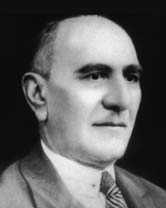
Ph.D., professor, and honored figure of Science of ASSR
Artsruni was born on June 10, 1857, in Nor Bayazet (now Gavar). He studied at the 1st gymnasium in Tbilisi until the 8th grade, then he went to Paris, received private education, and in 1885, graduated from the medical faculty of the Sorbonne University.
In 1889, Artsruni returned to Tbilisi and was appointed the city's sanitary doctor, at the same time worked in the city hospital as an otolaryngologist, and treated poor patients free.
From 1892-1893, Artsruni was one of the active organizers of the fight against the cholera epidemic.
During the civil war, he was the chief physician of the Red Army Hospital No. 15 for infectious diseases in Pyatigorsk. In 1920, he worked as a consultant and expert in the military hospitals of Tbilisi, was the vice-chairman of the board of the Armenian Red Cross Society, and later the chair.

From 1922, Artsruni headed the anatomy chairs of YSU Medical Faculty, then Yerevan Medical Institute.
In 1926, he became a professor, and in 1936, a doctor.
He also carried out extensive activities in the health care of schoolchildren and is rightfully considered one of the founders of the hygiene issues in schools in Armenia. On his initiative, the teaching of health care and physical education was introduced in a number of schools.
He published about 30 publicly available medical booklets and the "Arogjapahik newspaper" (1903-1905). Based on his long-term studies in schools, he also published the valuable work "School Healthcare" (1895).

In 1922, Artsruni’s textbook "Human Anatomy" was published. He also authored the novels "Illusion" and "The Girl".
His services are also great in the field of medical terminology. In 1924, Artsruni published the valuable work "Dictionary of Russian-Latin-Armenian Medical Terms", which has been a reference book for doctors and students for decades.
In 1930, he became an honored figure of science of the ASSR.
In 1943, Artsruni was awarded the medal "For Labor Courage".
Artsruni passed away on July 29, 1947, in Yerevan.
His bronze bust is placed in the lobby of the central building of YSU, and a commemorative plaque is attached to the wall of building No. 28, Parpetsi Street, Yerevan.
The Museum of Human Anatomy, which he founded at Yerevan State Medical University, is named after him, where his heart and brain are kept.

